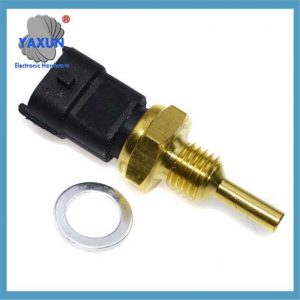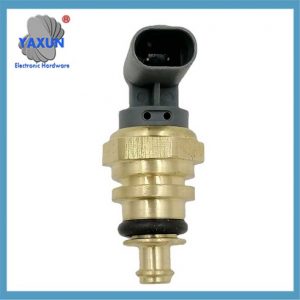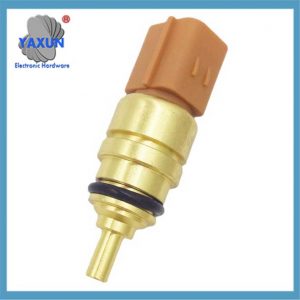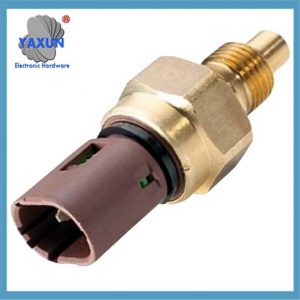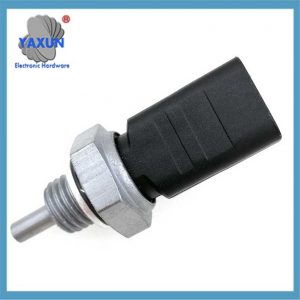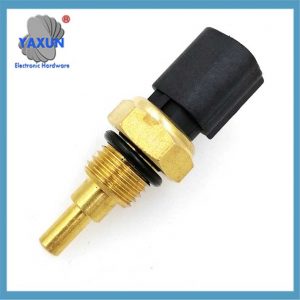Сензорът за температура на водата на двигателя на автомобила измерва температурата на водата или течна охлаждаща течност. Тези сензори се използват в различни приложения, включително автомобилни двигатели, Системи за охлаждане на вода, и индустриални процеси, За наблюдение и регулиране на температурата. Използвани в различни индустриални процеси за измерване на температурата на водата или други течности, често във връзка с регистратори на данни или системи за управление.
Основната функция на сензора за температура на водата е да следи температурата на охлаждащата течност на двигателя. Неговият основен компонент е термистор с отрицателен температурен коефициент (NTC). Стойността на съпротивлението на този материал намалява експоненциално, когато температурата се повиши, като около 2,5 kΩ при 20 ℃ и около 0,3 kΩ при 80 ℃. Тази функция му позволява да преобразува температурните промени в електрически сигнали.
По отношение на мястото на монтаж, повечето сензори (65%) са монтирани на водната риза на цилиндровия блок на двигателя/цилиндровата глава. Някои също са близо до термостата на главата на цилиндъра (22%) или изхода на радиатора (13%). Този дизайн е за директен контакт с охлаждащата течност, за да се осигури точно измерване на температурата.
Ролята на сензора е критична: при ниски температури, ECU ще увеличи инжекционния обем с 30% за подпомагане на студения старт; при високи температури, основното количество на инжекцията ще бъде коригирано. Това също ще повлияе на системата за запалване, като например увеличаване на ъгъла на запалване с 8-12° при -20°C и забавяне с 4-6° при 100°C за предотвратяване на експлозия. Освен това, контролът на празен ход също зависи от него, и скоростта ще бъде повишена до 1200-1500rpm при ниски температури.
По отношение на проявата на вина, често срещаните проблеми включват трудност при студен старт, нестабилна скорост на празен ход, необичайна работа на вентилатора, и т.н. Има няколко начина за диагностициране: използвайте мултицет, за да измерите захранващото напрежение (нормално 5V или 12V), прочетете потока от данни (нормалният сигнал за температура на водата е около 95 ℃), или измерете стойността на съпротивлението след нагряване (трябва да бъде 1,4-1,9kΩ при 30 ℃).
Сензорът за температурата на водата в автомобилния двигател е основният контролен елемент на системата за управление на двигателя. Функцията му, структура, принципът на работа и проявлението на повредата са както следва:
🔧 1. Структура и принцип на работа
Основен елемент: Приемане на термистор с отрицателен температурен коефициент (NTC), стойността на съпротивлението намалява експоненциално, когато температурата се повиши (като около 2,5 kΩ при 20 ℃, и пада до 0,3 kΩ при 80 ℃).
Преобразуване на сигнала: Преобразувайте промяната на температурата на охлаждащата течност в електрически сигнал (обикновено 1.3V-3.8V линейна промяна) и го предава на блока за управление на двигателя (ECU).
Местоположение на инсталацията:
Цилиндров блок на двигателя/водна риза на цилиндровата глава (счетоводство за 65%);
Шунтираща тръба на охлаждащата течност или близо до термостата.
Видове сензори за температура на водата:
Сензори за температура на охлаждащата течност на двигателя (ECTS):
Намерени в превозни средства, тези сензори следят температурата на охлаждащата течност на двигателя, осигуряване на обратна връзка към блока за управление на двигателя (ECU) за оптимално впръскване на гориво и момента на запалване.
Сензори за система за водно охлаждане:
Използва се в персонализирани PC контури за водно охлаждане или промишлени охладителни системи за наблюдение на температурата на охлаждащата течност и осигуряване на правилното разсейване на топлината.
Примери за приложения:
Автомобилна: Следене на температурата на охлаждащата течност на двигателя за оптимизиране на работата на двигателя и предотвратяване на прегряване.
Водно охлаждане: Поддържане на оптимални температури в контурите за водно охлаждане на PC за стабилна работа на системата.
Индустриални процеси: Мониторинг на температурите в производствените процеси, ОВК системи, и други приложения, включващи течности.
Аквакултури: Мониторинг на температурата на водата за оптимален растеж на риби или растения.
Океанография: Измерване на температурата на водата на различни дълбочини за изследване и мониторинг.
⚙️ 2. Основни функции
Сензорът за температура на водата предоставя данни за температурата в реално време на ECU за динамично регулиране на работата на двигателя:
Контрол на горивото: Ниска температура (<86℃): Увеличете количеството на инжекцията (до +30% обезщетение) за подобряване на производителността при студен старт;
Висока температура: Намалете инжекционното количество и оптимизирайте съотношението въздух-гориво.
Регулиране на запалването: Увеличете ъгъла на запалване при ниски температури (8–12° при -20℃), и забавяне при високи температури (4–6° при 100℃) за предотвратяване на експлозия.
Контрол на празен ход и разсейване на топлината: Увеличете скоростта на празен ход до 1200–1500 об/мин при ниски температури;
Задействайте пускането и спирането на охлаждащия вентилатор (високоскоростна работа при високи температури).
Дисплей на инструмента: Задвижете стрелката на манометъра за температурата на водата, 90℃ е идеалната работна температура.
Ключови характеристики:
Обхват на измерване: Диапазонът от температури, който сензорът може да измерва точно.
точност: Колко точно показанията на сензора съответстват на действителната температура.
Време за реакция: Скоростта, с която сензорът реагира на температурни промени.
Издръжливост: Способността на сензора да издържа на условията на околната среда (e.g., вода, температурни крайности).
Стил на монтаж: Как сензорът е прикрепен към системата (e.g., потапяне, тип резба).
⚠️ III. Проява на повреда и диагностика
(1) Типични симптоми на повреда:
Трудно стартиране на студена кола, колебания на празен ход или необичайно увеличение;
Индикация за анормална температура на водата (никакво движение, фалшиво високо или извън диапазона);
Охлаждащият вентилатор продължава да работи или изобщо не стартира;
Повишен разход на гориво и слабо ускорение.
(2) Метод за откриване:
IV. Механизъм за въздействие на повреда Изкривяване на сигнала: ECU преценява грешно температурата (като получаване на фиксиран сигнал от -40 ℃ или 130 ℃), което води до неправилна стратегия за инжектиране/запалване;
Линейна повреда: Отворена верига/късо съединение блокира предаването на сигнала, причинявайки дисбаланс на сместа;
Стареене на компоненти: Характеристиката на термистора или корозията на охлаждащата течност причинява намалена точност.
💎 Резюме
Сензорът за температура на водата е като “термометър” на двигателя. Неговата точност е пряко свързана с разхода на гориво, контрол на емисиите и механичен живот. Редовна проверка на съпротивителните характеристики и стабилността на сигнала (особено сравнението между горещи и студени състояния) може ефективно да предотврати системни повреди, причинени от повреда на сензора.
 English
English Afrikaans
Afrikaans العربية
العربية বাংলা
বাংলা bosanski jezik
bosanski jezik Български
Български Català
Català 粤语
粤语 中文(简体)
中文(简体) 中文(漢字)
中文(漢字) Hrvatski
Hrvatski Čeština
Čeština Nederlands
Nederlands Eesti keel
Eesti keel Suomi
Suomi Français
Français Deutsch
Deutsch Ελληνικά
Ελληνικά हिन्दी; हिंदी
हिन्दी; हिंदी Magyar
Magyar Bahasa Indonesia
Bahasa Indonesia Italiano
Italiano 日本語
日本語 한국어
한국어 Latviešu valoda
Latviešu valoda Lietuvių kalba
Lietuvių kalba македонски јазик
македонски јазик Bahasa Melayu
Bahasa Melayu Norsk
Norsk پارسی
پارسی Polski
Polski Português
Português Română
Română Русский
Русский Cрпски језик
Cрпски језик Slovenčina
Slovenčina Slovenščina
Slovenščina Español
Español Svenska
Svenska ภาษาไทย
ภาษาไทย Türkçe
Türkçe Українська
Українська اردو
اردو Tiếng Việt
Tiếng Việt

